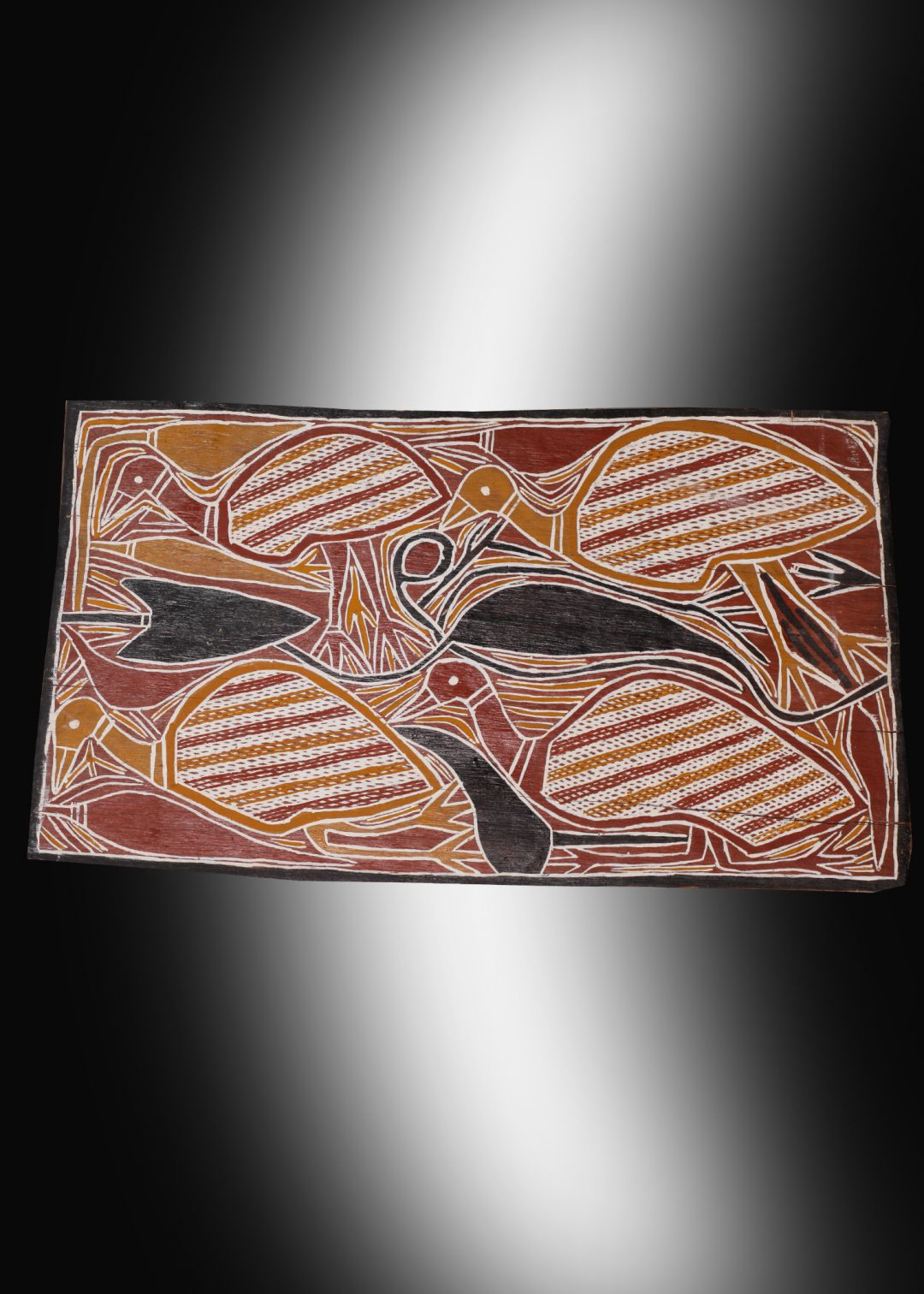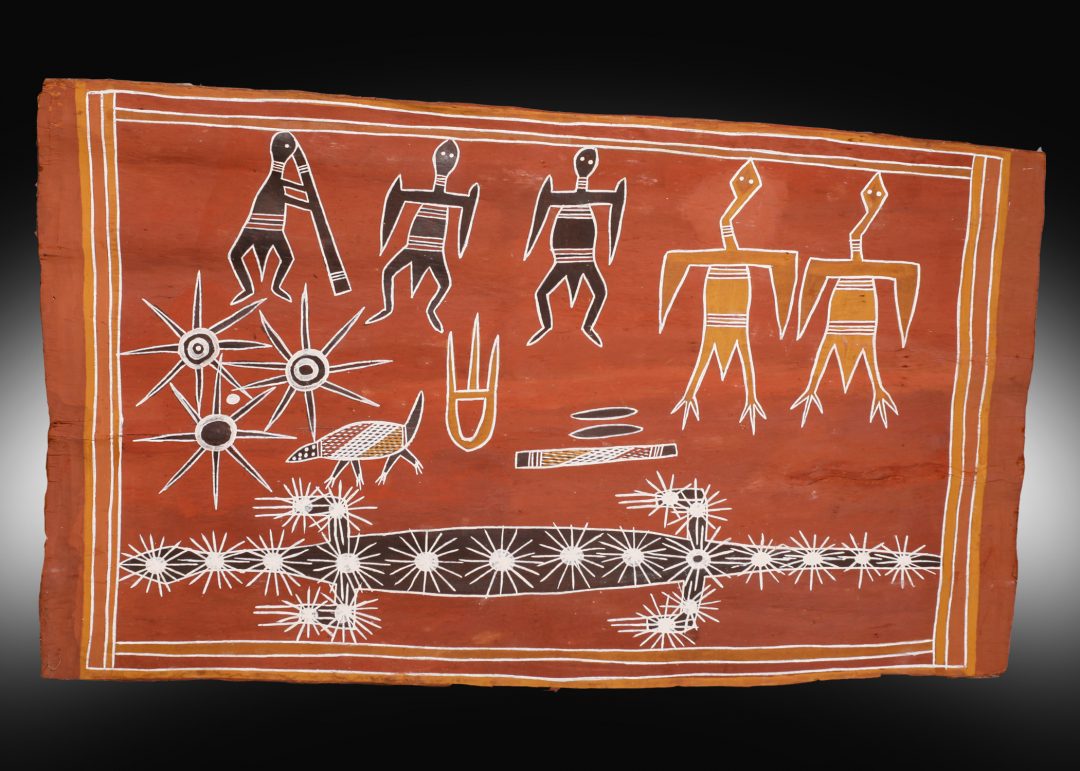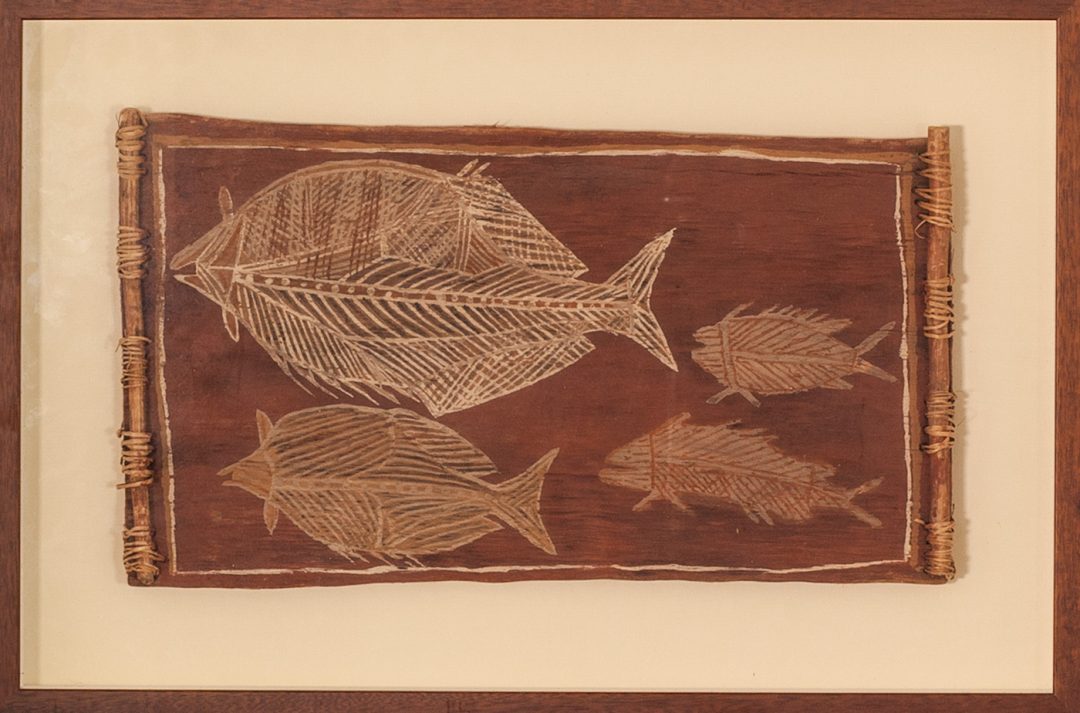Two Female Spirit Figures
- TitleTwo Female Spirit Figures
- ArtistJack Madagarlgarl (c1930-2000)
- LocationWestern Arnhem
- Datec1970
- Size108cm (L) x 67cm (W)
- Price$4,400.00
Two Female Spirit Figures
Collected: c1970 natural earth pigments on eucalyptus bark framed behind glass.
About the artist:
Little is written or known about this artist, which is not uncommon, although his work has been well collected and represented in collections.
General background:
These early paintings from Western Arnhem land visually use space to surround the objects. It is as if they were lifted from cave walls and placed on a sheet of bark. This form of art found mainly in West Arnhem Land is known as xray art where the artist paints what he sees as well as the internal structure of the animal including organs and skeletal structure or figurative art which represent mythical spirits such as the mimi figures.
About the painting:
This painting is of two female spirit figures. It has been suggested that they are possibly mimi figures . The mimi spirits are believed to have been the original inhabitants of the Oenpelli area. They still live on today, but can never be seen. The figures, almost weightless, who live in caves or in rocks. But as with all Aboriginal spirits or mythical beings, they lead a life that is similar to that of the people today. Indeed, it is believed that it was from the mimi spirits that the Aboriginal people first learnt the skills of hunting and fighting, and how to sing and dance.
Mimi are only one of a number of spirits which, according to the Gunwinggu people, inhabit their land. Amongst others are the nakidjkidj and dadduhe (dadubi), which are dangerous or evil spirits. Nakidjkidj are believed to be cannibals and are greatly feared; they live everywhere in the bush, unlike the mimi, who are found only in the rocky sandstone area. The nakidjkidj are associated with sorcery, and are always hostile to human-beings. These type of spirit figures are usually represented in an aggressive manner.
The mimi, on the other hand, are not necessarily hostile to people. However, many of the stories concerning mimis contain strong warnings against wrong behaviour which indicate that there is definitely a concept of danger which determines the Gunwinggu relation to these spirit beings.
As no Aboriginal has seen mimi spirits, there is some doubt relating to their habits and dwelling places. One of the artists said:
Mimi hunted a long time ago. We cannot see them, they might have hid themselves for a long time. They might be in the rocks, we do not know, we cannot see them. They are spirits, they might be in caves, we do not know. We walk in our land, they might walk in theirs or they might still be in the rocks with their friends, the big mimi, who hid themselves for a long time. They might have got married and had children
However, long ago, the first people, the Nayuhungki, were able to observe; Mimi, and imitated their actions. Thus the Aboriginal people learnt many of the skills that were necessary for day-to-day existence.
The painting is in excellent condition framed behind glass
Two Female Spirit Figures
Collected: c1970 natural earth pigments on eucalyptus bark framed behind glass.
About the artist:
Little is written or known about this artist, which is not uncommon, although his work has been well collected and represented in collections.
General background:
These early paintings from Western Arnhem land visually use space to surround the objects. It is as if they were lifted from cave walls and placed on a sheet of bark. This form of art found mainly in West Arnhem Land is known as xray art where the artist paints what he sees as well as the internal structure of the animal including organs and skeletal structure or figurative art which represent mythical spirits such as the mimi figures.
About the painting:
This painting is of two female spirit figures. It has been suggested that they are possibly mimi figures . The mimi spirits are believed to have been the original inhabitants of the Oenpelli area. They still live on today, but can never be seen. The figures, almost weightless, who live in caves or in rocks. But as with all Aboriginal spirits or mythical beings, they lead a life that is similar to that of the people today. Indeed, it is believed that it was from the mimi spirits that the Aboriginal people first learnt the skills of hunting and fighting, and how to sing and dance.
Mimi are only one of a number of spirits which, according to the Gunwinggu people, inhabit their land. Amongst others are the nakidjkidj and dadduhe (dadubi), which are dangerous or evil spirits. Nakidjkidj are believed to be cannibals and are greatly feared; they live everywhere in the bush, unlike the mimi, who are found only in the rocky sandstone area. The nakidjkidj are associated with sorcery, and are always hostile to human-beings. These type of spirit figures are usually represented in an aggressive manner.
The mimi, on the other hand, are not necessarily hostile to people. However, many of the stories concerning mimis contain strong warnings against wrong behaviour which indicate that there is definitely a concept of danger which determines the Gunwinggu relation to these spirit beings.
As no Aboriginal has seen mimi spirits, there is some doubt relating to their habits and dwelling places. One of the artists said:
Mimi hunted a long time ago. We cannot see them, they might have hid themselves for a long time. They might be in the rocks, we do not know, we cannot see them. They are spirits, they might be in caves, we do not know. We walk in our land, they might walk in theirs or they might still be in the rocks with their friends, the big mimi, who hid themselves for a long time. They might have got married and had children
However, long ago, the first people, the Nayuhungki, were able to observe; Mimi, and imitated their actions. Thus the Aboriginal people learnt many of the skills that were necessary for day-to-day existence.
The painting is in excellent condition framed behind glass




